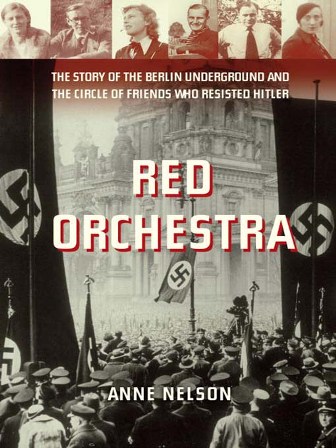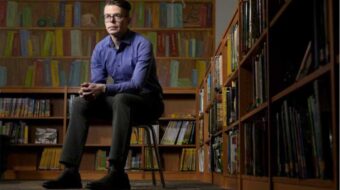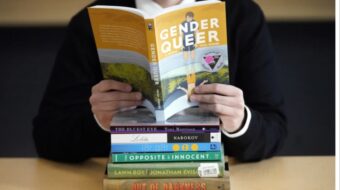
The Book Thief
By Markus Zusak
Alfred A. Knopf, 2005
Red Orchestra – The Story of the Berlin Underground and the Circle of Friends Who Resisted Hitler
By Anne Nelson
Random House, 2009
It was the Mexican historian George Santayana who said those who cannot remember the past are condemned to repeat it. In their majority, U.S. voters showed last year that they grasped some of history’s lessons. The unity of the core movements, including labor and women, was one result. The election of Barack Obama was another. Two recent books, one fiction, one non-fiction, bring ringing historical authority to this.
“The Book Thief” by Markus Zusak brings to life the everyday struggles of a typical and essentially apolitical German working class family in the late 1930s and early 1940s. While loosely based on the author’s grandmother’s experiences, it is fiction. “Red Orchestra – The Story of the Berlin Underground and the Circle of Friends Who Resisted Hitler” by Anne Nelson reveals the stories behind one, and at times, more than one, antifascist group functioning in Germany during WWII. Anne Nelson did extraordinary research here for this nonfiction drama.
Have you ever seen one of those history channel stock film reel shots of a Nazi book burning? You’ll experience one in “The Book Thief.” And this time, a small hand will reach in to rescue a smoldering book. You’ll wish “The Communist Manifesto” by Karl Marx and Fredrick Engels or “The Iron Heel” by Jack London were rescued. What book it is will surprise you.
Liesel Meminger is the book thief. We see the rise of fascism through her preteen experiences in a rough start in life. All we know is that her mother is sickly and her father is gone. The Hubermanns are her foster parents. She did take note that when her biological father’s name was mentioned, the word communist – “that strange word” – also came into the conversation. We experience new Nazi laws and the persecution of the Jews through Liesel’s eyes and those of her new family.
The book thief conducts her “hobby” wherever she can, a graveyard, even the fascist mayor’s library. But she has help as the main viewpoint character with the narration. The author creatively and dauntingly uses none other than the Grim Reaper himself. You see, fascism and war need the collecting of souls. He has a busy and exhausting job.
“The Red Orchestra” starts more expansively in the United States. It’s the 1920s and Greta Lorke is leaving her German homeland for the USA and the University of Wisconsin. There she meets future antifascists Arvid Harnack and his American wife, Mildred Fish. Upon returning to Germany, and along with her German husband, Adam Kuckhoff, they will play crucial roles in their resistance circle in Berlin before and during World War II.
Readers will have particular interest in two Americans. The aforementioned Mildred Fish Harnack would become the only American woman to be executed for her role in the resistance. She was born in Milwaukee, an academician with a love of literature and languages. She played a direct role in the resistance including meetings with Soviet agents and direct contact with the U.S. Embassy. John Sieg was an automobile worker and writer born in Detroit. He migrated to Germany, joined the Communist Party there in 1929 and worked as a railroad employee. Sieg would hold up troop transport and munitions trains for hours unbeknownst to his bosses.
Anne Nelson loses the viewpoint character at times, but the story is so riveting that the reader will hardly notice. Many German Communists sought refuge in the Soviet Union after 1933 due to the Nazi terror. The author states that Stalin persecuted and killed many of them due to purported connections to Leon Trotsky. She also says that some casualties, which reach into the millions and far beyond the German Communists, are “painfully uncertain.” This reviewer did note references to the Hoover Institute, a notorious anticommunist think tank, in connection to these numbers.
Concerning the book’s title, The Rote Kapelle (Red Orchestra) was so labeled by the Nazis for their radio transmissions to the Soviets from inside Berlin. Wald Kapelle (Orchestra of the Woods) was another resistance group doing the same from occupied Europe to Britain.
Greta Kuckhoff was one of the few Berlin resisters to survive. After the war, she was stunned at the American’s approach to the Nazis when they were recruited for intelligence work as the Cold War ensued. Unbelievably, the West German legal system actually upheld the convictions of Germans during the war for resistance activities. Greta Kuckhoff joined the East German Communist Party. By 1950, she was head of the German Democratic Republic (East German) Central Bank.
What these two books do best is put the lie to the claim that the German people did nothing to resist the rise of fascism there. “The Book Thief” is one of the few books that engages the iron heel of fascism and still can be shared with young adults due to the humor and coming of age experiences of Liesel. Red Orchestra is for the politically minded. One lesson for today is that we need to grow the united movement that thwarted attempts by McCain and Palin to drive our country further toward the political right’s abyss. And with tens of thousands of U.S. troops ready to deploy to Afghanistan, this has added import.












Comments